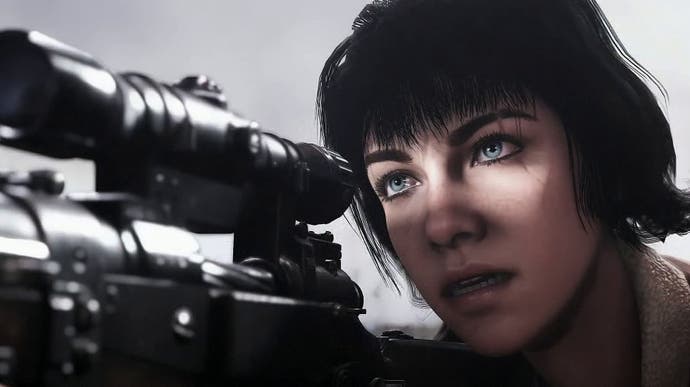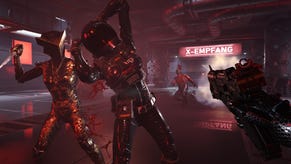How Wolfenstein: Youngblood scales from top-end PC to Nintendo Switch
With PS4 and Xbox One in-between.
Having sampled Wolfenstein: Youngblood across all platforms now, it's fair to say that technologically speaking at least, Machine Games' latest is very a side-step from its excellent work in Wolfenstein: The New Colossus. There's the sense that the id Tech 6 feature set hasn't evolved beyond the additional enhancements to the engine found in TNC and that this time around, Innovation comes from gameplay, with cooperative play the key new mechanic, paired with more thoughtful level design likely due to the influence of co-developer Arkane Studios.
Youngblood launched at the tail-end of last week with little to no fanfare, which is surprising as this is a full-blooded multiplatform roll-out with considerable resources and talent put behind it. Not only do we get PC, Xbox One and PlayStation 4 releases, but Switch received a day and date release too with Austin-based developer Panic Button once again at the conn. The turnout for the game across consoles is diverse and although genuine surprises are limited, performance isn't quite the same as it was on the last Wolfenstein release.
The PC version is the easiest to cover in that if you're au fait with The New Colossus, you'll know exactly what to expect here. There are no pretensions of new engine technology, the options selections are entirely identical, performance is much the same - although with two players in the same scene pushing out effects-heavy pyrotechnics, you can see some additional GPU load. The bottom line is that technologically speaking, it's more of the same - you're simply getting a bunch of new levels with a different design ethos, with the added benefit of cooperative play.
Pre-launch, we were eagerly anticipating DXR ray tracing support - now confirmed for reflections and ambient occlusion - but the enhancement isn't ready for show time, so we'll have to wait to see how id software has tackled this fascinating technology. You do get the latest Nvidia enhancements otherwise though, meaning that the variable rate shading support found in TNC is available here, adding around 10 to 15 per cent more performance for new Turing-based cards, depending on the scene.
There's a certain amount of familiarity in the console builds too. All of them - bar Switch - target id Tech 6's signature 60 frames per second, but dynamic resolution scaling is used to sustain performance. PS4 and Xbox offer three rendering options: DRS can be enabled or disabled, while an extra 'aggressive' option allows resolution to drop even lower in order to better sustain 60fps. Aggressive DRS was added to The New Colossus in a later patch, and it's good to see it return in Youngblood as it delivers a genuine improvement to overall fluidity.
Where things do seem different to the last Wolfenstein outing is in how the game scales. Looking back over our notes, both the X and Y axis could scale simultaneously on the old game, while Youngblood seems to reserve its DRS mode to the horizontal axis only. Interesting, both Xbox One X and PlayStation 4 Pro mostly seem to deliver 1440p resolution, though in the case of the Pro, 2176x1440 is the more typical number during the action. Owing to the surprise release of the Doom back catalogue, we've not had the chance to sample Xbox One S, but the vanilla PS4 also employs DRS with a 1920x1080 high-end, dropping to 1440x1080 under load.
A locked 60 frames per second is off the cards on all consoles, but it gets close enough in most cases to deliver a good experience, with motion blur helping a touch in hiding the dropped frames. The best advice would be to keep DRS active and if the frame-rate drops are noticeable to you, engage the aggressive setting - despite the resolution drop, it's our preferred way to play.
Of all the console versions, it's likely to be the Switch release that will prove most interesting bearing in mind the huge constraints imposed on the game by the fact it is running on a mobile-orientated chipset. Panic Button has delivered an impressive port - though again, if you've played The New Colossus or Doom 2016, you should have an idea of what to expect. Frame-rate tops out at 30 frames per second rather than the established 60 on the other consoles and just about any form of combat will see drops beneath that - mid-20s can be fairly common in heavy scenes.
And yes, expect a somewhat blurry experience on Switch. The engine's signature use of temporal anti-aliasing integrated into an extensive post-process pipeline delivers a 'filmic' look on all systems but extra resolution still delivers a level of clarity that is essentially absent on the Nintendo hybrid. Dynamic resolution is once again in play with upper bounds set at 720p docked and around 540p in handheld mode. Interestingly, while it can't be totally ruled out, we haven't yet seen same 360p lower bounds witnessed in The New Colossus, and while like-for-like comparisons are obviously not possible (as there is no crossover in content) the overall the presentation does look a touch cleaner in Youngblood.
Do expect to see a range of visual downgrades though: ambient occlusion is pared back - if not outright removed - while volumetric precision and motion blur are at the lowest end, screen-space reflections are absent and texture quality is nothing like as good as the other builds, adding further to the lack of clarity. It's for all of these reasons that Youngblood really does play best as a handheld experience - the performance penalty vs docked is essentially non-existent and despite the cut in resolution, the compromises are far more difficult to pick up on when playing on the go. Displayed on a living room TV, the experience definitely falls short but it holds up rather well portably - and obviously the 'takeaway and play' aspect of the Switch release sets it apart from all other versions of the game.
There are some interesting variances in the console builds when stacking up Youngblood with The New Colossus. At the lower end, the Switch version has the same style of performance but there does seem to be improvement in clarity. Meanwhile the Xbox One X build seems to run at a generally lower resolution than its predecessor and performance doesn't seem quite so solid. A genuine 4K ultra HD experience is available as an option, but running at circa 40fps isn't entirely ideal - though it will be interesting to revisit this via backwards compatibility on future Xbox hardware.
Overall though, Wolfenstein: Youngblood is well worth checking out and it comes across almost like the expansion packs for the id software games of old: retail products created by other developers, delivering their own take on the series. The unique spin in this case is definitely co-op, which is both a strength and a weakness. Many points in the game require the two characters to team-up to progress, and it's much easier with two human players, as opposed to relying on the CPU AI which can add friction to the experience. Fundamentally though, Youngblood is a solid experience, if not the big leap we might have been hoping for after the technical advances showcased in The New Colossus.











